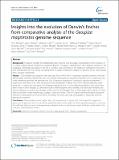Insights into the evolution of Darwin’s finches from comparative analysis of the Geospiza magnirostris genome sequence

View/
Author
Rands, Chris M
Darling, Aaron
Kong, Lesheng
Webster, Matthew T
Clabaut, Céline
Emes, Richard D
Heger, Andreas
Meader, Stephen
Eisen, Michael B
Teiling, Clotilde
Affourtit, Jason
Boese, Benjamin
Grant, Peter R
Grant, Barbara Rosemary
Eisen, Jonathan A
Ponting, Chris P
Note: Order does not necessarily reflect citation order of authors.
Published Version
https://doi.org/10.1186/1471-2164-14-95Metadata
Show full item recordCitation
Rands, Chris M, Aaron Darling, Matthew Fujita, Lesheng Kong, Matthew T Webster, Céline Clabaut, Richard D Emes, et al. 2013. Insights into the evolution of darwin’s finches from comparative analysis of the geospiza magnirostris genome sequence. BMC Genomics 14: 95.Abstract
Background: A classical example of repeated speciation coupled with ecological diversification is the evolution of 14 closely related species of Darwin’s (Galápagos) finches (Thraupidae, Passeriformes). Their adaptive radiation in the Galápagos archipelago took place in the last 2–3 million years and some of the molecular mechanisms that led to their diversification are now being elucidated. Here we report evolutionary analyses of genome of the large ground finch, Geospiza magnirostris. Results: 13,291 protein-coding genes were predicted from a 991.0 Mb G. magnirostris genome assembly. We then defined gene orthology relationships and constructed whole genome alignments between the G. magnirostris and other vertebrate genomes. We estimate that 15% of genomic sequence is functionally constrained between G. magnirostris and zebra finch. Genic evolutionary rate comparisons indicate that similar selective pressures acted along the G. magnirostris and zebra finch lineages suggesting that historical effective population size values have been similar in both lineages. 21 otherwise highly conserved genes were identified that each show evidence for positive selection on amino acid changes in the Darwin's finch lineage. Two of these genes (Igf2r and Pou1f1) have been implicated in beak morphology changes in Darwin’s finches. Five of 47 genes showing evidence of positive selection in early passerine evolution have cilia related functions, and may be examples of adaptively evolving reproductive proteins. Conclusions: These results provide insights into past evolutionary processes that have shaped G. magnirostris genes and its genome, and provide the necessary foundation upon which to build population genomics resources that will shed light on more contemporaneous adaptive and non-adaptive processes that have contributed to the evolution of the Darwin’s finches.Other Sources
http://www.ncbi.nlm.nih.gov/pmc/articles/PMC3575239/pdf/Terms of Use
This article is made available under the terms and conditions applicable to Other Posted Material, as set forth at http://nrs.harvard.edu/urn-3:HUL.InstRepos:dash.current.terms-of-use#LAACitable link to this page
http://nrs.harvard.edu/urn-3:HUL.InstRepos:11829051
Collections
- FAS Scholarly Articles [18292]
Contact administrator regarding this item (to report mistakes or request changes)


